By Dr. Alberto Ferreiro*
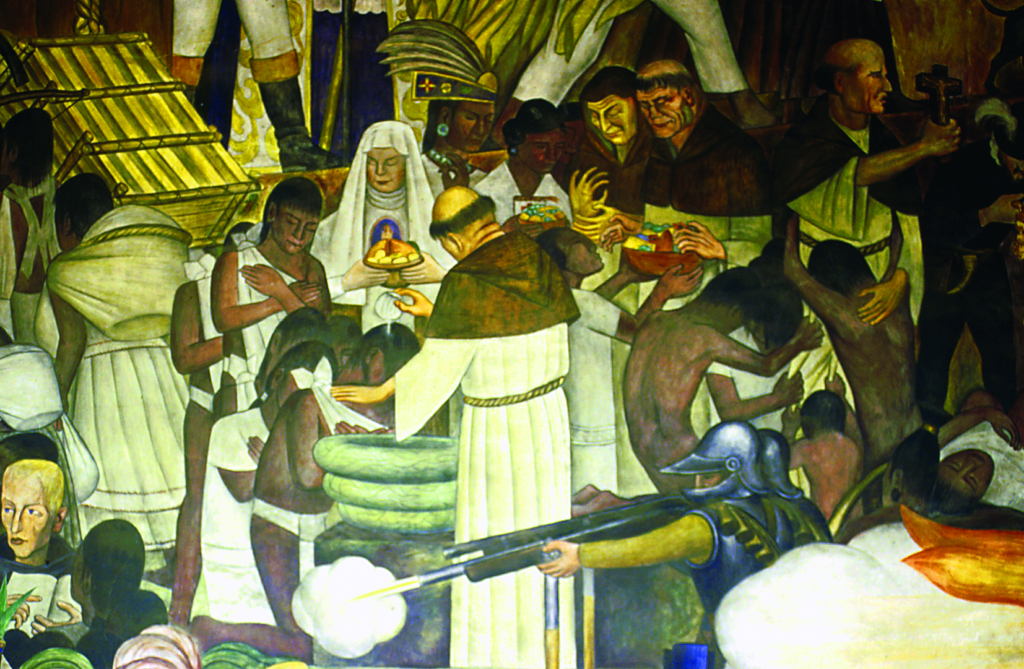
Dominicans preaching the Gospel, detail from a mural by Diego Rivera in Mexico City, Mexico.
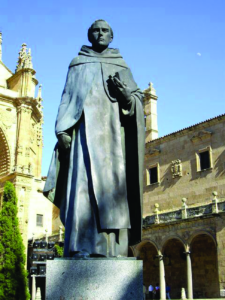
Statue of Francisco de Vitoria at the Dominican San Esteban Monastery, named after St. Stephen the Martyr, in Salamanca, Spain
I want to begin this essay on Francisco de Vitoria (1483-1546) on a personal note to explain how I became acquainted with him. Also, how I eventually reached the conclusion that he was one of the most important people of his era and that his legacy is of immense relevance today. In 1989 I founded a summer Spanish Language and Culture program to take university students to the University of Salamanca. I did so for 30 years (1989-2019); 900 students participated. One of the major monuments there is the historic Dominican San Esteban Monastery, named after St. Stephen the Martyr. Francisco de Vitoria lived there and is buried inside in the “Cemetery of the Theologians.” Year after year, taking students for visits, I became more acquainted with Francisco, which prompted me to read his works and books about him. Since then, in other venues I have lectured on him. This is the first time I am writing to reach a wider audience.
Francisco is unknown in narratives about Western civilization. I have taught a Western civilization class for 35 years at a university. The textbooks for that class have always been large tomes of five to six hundred pages or more. Searching the indexes you will not find a single mention of Francisco or the School of Salamanca. Yet, there are glimmers of recognition here and there. For example, in a hall in the United Nations in New York there is bust of Francisco de Vitoria donated by King Juan Carlos I of Spain that acknowledges his work for indigenous rights.

Domingo de Soto (1494-1560)
At the UN office in Geneva, Switzerland, a room bears his name, and added to that, another bust was placed at the Organization of American States in Washington D.C. There is even a private University of Francisco de Vitoria in Spain.
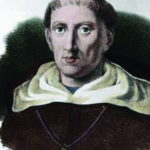
Melchior Cano (1509-1560)
Overall, however, Francisco lies in obscurity — mainly in the English speaking world. In light of the current growing hostility to anything Western and Christian, it will be a tough uphill battle to give him the recognition that he deserves. It was he, not the French philosophes led by Voltaire and John Locke, who first proposed ideas that contributed to the development of universal human rights and international law. Although they deserve recognition on this front, these groundbreaking teachings originated with Francisco de Vitoria, Domingo de Soto (1494–1560), and Melchior Cano (1509–1560) in Salamanca (see Mauricio Beuchot, Filosofía y Política en Bartolomé de las Casas, pp. 22-23).
Francisco de Vitoria—His Life and Times
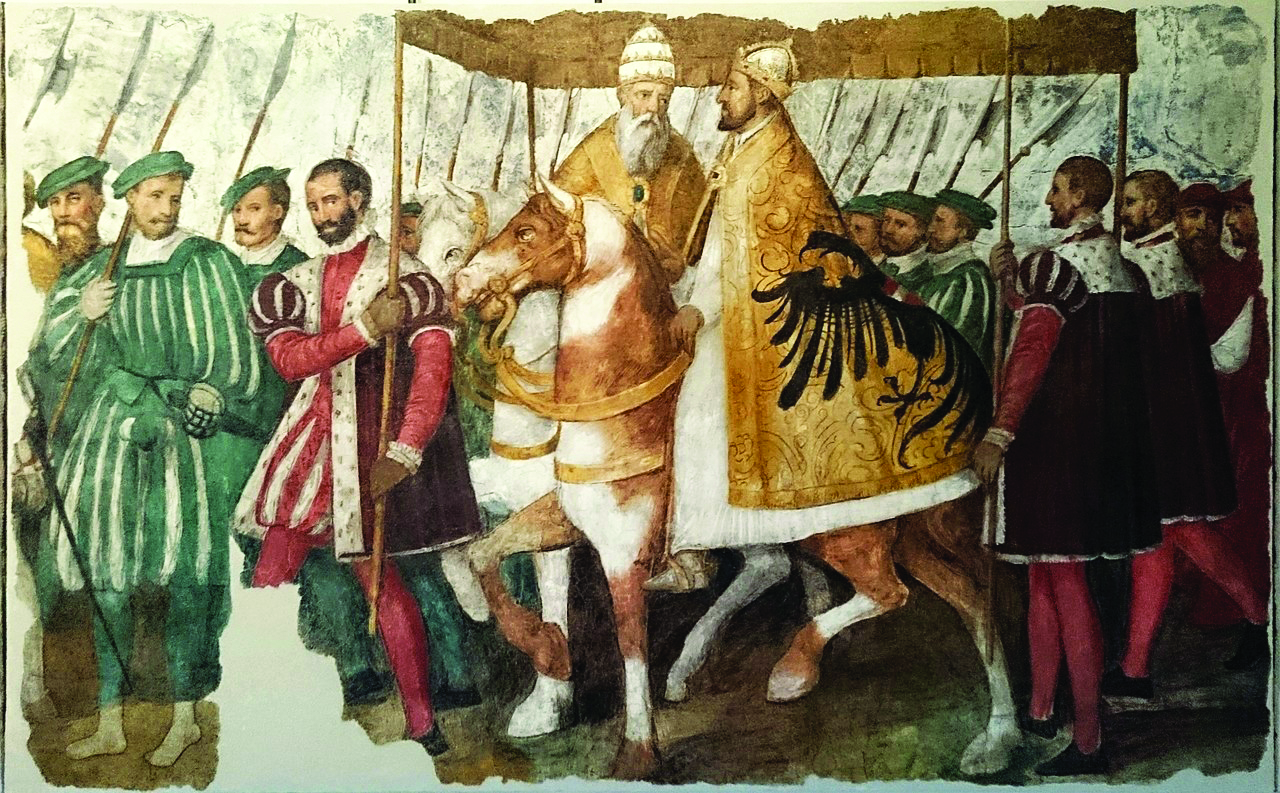
Pope Clement VII and Emperor Charles V, by Jacopo Ligozzi, c. 1580.
De Vitoria was born in Burgos, Spain, in 1483, likely on October 4, and died in Salamanca on August 12, 1546. He spent some time in Paris studying; his main work, however, transpired in Salamanca, in what is now Castilla-León. He was a canon lawyer, theologian, philosopher, renowned lecturer, and above all, brave defender of the rights of the indigenous people of the Americas.
Francisco was born into a noble family that had Jewish roots; they were conversos. In 1504 he entered the Dominican monastery of St. Paul in Burgos.
He taught theology at the University of Paris starting in 1516; there he obtained his doctorate in sacred theology.
He left Paris in 1523 for Valladolid to teach theology at the renowned St. Gregory College. In 1526 he was given the prestigious Chair of Theology at the University of Salamanca, where he remained until his death in the Dominican San Esteban Monastery in 1546. Francisco was an adviser to Holy Roman Emperor Charles V (Charles I of Spain), who even attended one of his classes in 1534. They did not always see eye to eye, but that did not lead to a break in their cordial relationship.
In 1539 the Emperor wrote to Francisco to inquire about the possibility of sending 12 learned and pious friars to Mexico to found a university.
In 1545 Prince Philip (later Philip II of Spain) wrote on his father’s behalf to invite Francisco to the Council of Trent. He declined because he was already too ill to travel, and he died the next year at age 60.
Over the course of Francisco’s teaching career, it is estimated that he taught nearly 5,000 students. Twenty-four of them managed departments of letters or theology at the University of Salamanca. In 1548 two occupied the Chair of Thomas Aquinas in the University of Alcalá de Henares.
Francisco lived a full life marked by many notable lasting accomplishments (Ramón Hernández, Francisco de Vitoria, pp. 9-40).
Francisco de Vitoria—His Intellectual Achievement
Francisco de Vitoria is considered a leading voice among the Dominicans, who in the early 1500s raised his voice to denounce the abuses committed by his fellow Spaniards in the Americas. The other major opponents were Antón Montesinos (born in Seville in 1485; died in Venezuela in 1540) whose fiery sermon on the Fourth Sunday of Advent on December 21, 1511 for the Feast of John the Baptist, in which he excoriated the exploiters, triggered an intense debate about the abuses. Antón was a student at the University of Salamanca and was ordained in the Dominican San Esteban Monastery, the same one where Francisco de Vitoria made his mark (Ramón Hernández, et al, El Grito y su Eco. El Sermón de Montesino. San Esteban, Salamanca, 2011).
The other Dominican luminary was Bartolomé de Las Casas (1484-1566) who wrote the famous A Short Account of the Destruction of the Indies and was active in the intense debates that took place regarding the fate of the Indians in the Americas. Bartolomé spent time in Salamanca where he received a licentiate in canon law.
Unlike Antón and Bartolomé, Francisco never set foot in the Americas. He nevertheless had an immense sway on both. Bartolomé and Francisco never met in person, but the former was deeply influenced by Francisco’s views, which helped him to successfully defend, in the great debates, the rights of the indigenous peoples.
Another Dominican in San Esteban in Salamanca who deserves mention and was close to Francisco was Domingo de Soto. He had direct contact with Bartolomé (Ramón Hernández, Francisco de Vitoria, pp. 79, 82); Mauricio Beuchot, Filosofía y Política en Bartolomé de las Casas, pp. 17-18). Together they became a formidable front to oppose the exploitation of the indigenous peoples and provoke open debates to reverse the exploitative policies in the new Spanish colonies; no similar debates had ever occurred anywhere up to that time about the morality of slavery.
Another major accomplishment of Francisco was the founding of what has been called the School of Salamanca, not to be understood as a literal institution. Rather, it was formed as a group of likeminded theologian/philosophers, whose core was Francisco, Domingo, and Melchior, all from Dominican San Esteban Monastery in Salamanca, where they are all buried.
There were others who were part of this intellectual movement elsewhere, notably in the College of Saint Gregory in Valladolid.
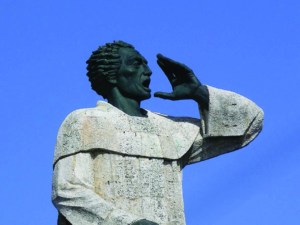
Antón Montesinos (1485-1540)
They rehabilitated Thomism, which had been declining for some time; this made the University of Salamanca the center of this revival of a new Thomistic Scholasticism. They used Thomism to address the many challenges of the new evangelization in the Americas and the burning question of whether slavery was rightfully legal or moral (Benjamin Durham, Bartolomé de Las Casas, p. 7).

Bartolomé de Las Casas (1484-1566)
What is amazing about Francisco is that he did not write any books on these topics in the normal sense of the word. His extensive lectures survived only in the notes that his students took. There was also the practice that he annually delivered summaries of the courses for that year; these were mandatory to attend. He gave a large number in Salamanca and they became the most important. These lecture summaries are called the Recapitulations, which he rewrote and edited to refine them. These were edited and published later in Antwerp in 1604; from that point onward their diffusion well beyond Spain was guaranteed. They came eventually into the hands of Hugo Grothius in the Netherlands, who extensively quoted the Recapitulations in his De Iure Belli et Pacis (“On the Law of War and Peace”), a seminal work published in 1625 that shaped John Locke and others in the 1600s.
These ideas of Francisco and the School of Salamanca found their way to the French Enlightenment thinkers, who used them to confront the slavery of their day. Francisco and his fellow Dominicans by then were long gone and received no credit as the originators of this cutting-edge thinking. The main teachings from Francisco’s Recapitulations can be summarized as follows, keeping in mind that there are many more (Ramón Hernández, Los Derechos Humanos, pp. 179196):
- Man was created in freedom and so, according to Natural Law, is free.
- Man is by nature social and civil.
- All men are equal; none is superior, by Natural Law, with respect to others
- The Indians are entitled to their customs and no coercion with violence should be used to stop them, except for inhuman laws and customs such as human sacrifice or cannibalism, which violate Natural and Divine Law.
- The Indians have the right to their properties, domains, laws, judges, and industries and businesses. The Indians are true masters of their things, like Christians of theirs.
- The Indians have the right to stay in their religion and no one should use force to make them Christians.
- Christians by divine right have the right to preach the Gospel in the provinces of the Indians
- Indians are free to change sovereignty with the consent of the majority and without duress.
- All colonization or protectorate is by nature temporary and as soon as possible should be prepared to emancipate the colonized country.
- The Pope has no claim to temporal authority to rule over the New World.
- The Pope has no authority to give European rulers dominion over primitive peoples; the most he can do is grant spheres for missionary work
- No one is born to become a slave to someone else. The Recapitulations discarded several of Aristotle’s teaching on slavery, including that:
Some humans were born to be slaves and others to be masters.
Those born to be slaves have inferior souls and defective minds.
They are useful only for physical labor (Aristotle, Politics, 1, 3-7).
In fact, Aristotle’s teachings on slavery were wholly rejected as contrary to Natural Law and the Holy Scriptures (Thomas E. Woods, How the Catholic Church Built Western Civilization, pp. 133-151).
A fair question to ask is, what impact did these teachings have on Spain’s colonization policy and on the indigenous in the colonies? One answer is that the Spanish monarchy ordered that the encomiendas should be dismantled. These were the equivalent of the slave plantations in America’s Confederate South. It took time and persistence to make this decree a reality; the Dominicans became the eyes and ears that insisted that the order be implemented.
Also, as a result of the great debates that ensued over slavery in Spain, laws against slavery were crafted in Burgos (1512-1513) and in Valladolid (1542). The papacy fully backed the anti-slavery legislation; Pope Paul III declared slavery a mortal sin in 1537. Any Catholic involved in any shape or form in slavery was pronounced excommunicated.
Spain was in fact the first colonizing empire to hold these debates and to rule against slavery. It was not a rapid and perfect eradication — the abuses continued, and offenders were plenty. In the long run, however, institutional slavery became a thing of the past in the Spanish colonies. (It is telling that there are no Indian reservations south of the modern border of the United States; the indigenous population was and still is the majority population in Mexico and in Central and South America.)
There was another factor that contributed to this demographic reality: the Spanish Crown and the colonial authorities never prohibited interracial marriages. Indeed, it was encouraged, in part with the hope that it would make conversion to Catholicism easier. Spain, moreover, had a long history of mixed marriages long before Columbus stumbled on the Americas.
Northern Europeans, mainly English and French, and the Muslim caliphates became the greatest purveyors of slavery, far exceeding by any measure the Spanish and Portuguese. The English and French eventually had their own Francisco, Domingo, Antón, and Bartolomé in the persons of John Newton, Quakers, Methodists, Universalists, Catholics, and the philosophes of the Enlightenment who helped to dismantle their slave empires. There was unfortunately enormous irreparable damage; whole tribes were wiped out and those left were herded into reservations. So they became near-invisible minorities even to this day in the USA and Canada. But the situation south of the USA is a far different situation today for the descendants of the indigenous tribes. The contributions of Francisco de Vitoria, the School of Salamanca, and the Dominicans were profound.
Their contributions to the development of International Law and Human Rights are well documented.
The more-celebrated early modern champions of liberty took a page, directly or through intermediaries, from the thought of the sages of Salamanca.
We are living in a time of unprecedented, rampant factory slave labor, sex trafficking of people of all ages, foreign policies that exploit, threats to surviving indigenous peoples (as in the Amazon), and so many more destructive institutions, ideologies, and policies.
If ever there was time again to hear Francisco’s voice in the current chaotic wilderness that we are living in, it is now: Sancte Francisce, ora pro nobis.

Franciscan evangelizers in the wake of the Spanish conquistadors
BIBLIOGRAPHY
Benjamin Durham, “Bartolomé de Las Casas and the School of Salamanca: In defence of the Amerindians and in opposition to the Encomienda,” Academia, On-line, pp. 1-15.
Mauricio Beuchot, Filosofía y Política en Bartolomé de las Casas. San Esteban, Salamanca, 2013.
Ramón Hernández, et al, El Grito y su Eco. El Sermón de Montesino. San Esteban, Salamanca, 2011.
Ramón Hernández, Francisco de Vitoria. Salamanca, 2011.
Ramón Hernández, Los Derechos Humanos. Francisco de Vitoria. San Esteban, Salamanca, 2003.
Thomas E. Woods. How the Catholic Church Built Western Civilization. Regnery Publishing, Washington D.C., 2005.
*Dr. Alberto Ferreiro is Professor Emeritus of History at Seattle Pacific University, and the author of 11 books and more than 100 scholarly articles. He can be reached at [email protected].






Facebook Comments